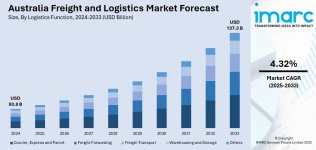vivekkumar
Member

The latest report by IMARC Group, “Australia Freight and Logistics Market Report by Logistics Function (Courier, Express and Parcel, Freight Forwarding, Freight Transport, Warehousing and Storage, and Others), End Use Industry (Agriculture, Fishing and Forestry, Construction, Manufacturing, Oil and Gas, Mining and Quarrying, Wholesale and Retail Trade, and Others), and Region 2025-2033,” provides an in-depth analysis of the freight and logistics market in Australia. The market size reached USD 93.8 Billion in 2024 and is projected to grow to USD 137.3 Billion by 2033 , exhibiting a CAGR of 4.32% during the forecast period.
Report Attributes and Key Statistics:
- Base Year: 2024
- Historical Years: 2019–2024
- Forecast Years: 2025–2033
- Market Size in 2024: USD 93.8 Billion
- Projected Market Size in 2033: USD 137.3 Billion
- CAGR (2025–2033): 4.32%
A fast-growing freight and logistics market in Australia is being fueled by surging e-commerce activity, burgeoning trade volumes, and expanding transport infrastructure. The adoption of electric vehicles, energy-efficient warehousing, and renewable energy for transport operations is playing a key role in strengthening supply chains, while rising safety and compliance demands—alongside sustained online retail growth—are contributing to the increasing market demand.
Request For Sample Report: https://www.imarcgroup.com/australia-logistics-market/requestsample
Australia Freight and Logistics Market Trends and Drivers:
The sector is transforming rapidly, with logistics providers integrating advanced technologies such as AI, automation, IoT, and predictive maintenance to boost efficiency. Real-time visibility tools are enhancing route planning and delivery accuracy. The shift toward green logistics—featuring EV fleets, energy-efficient warehousing, and renewable energy—is aligning operations with sustainability mandates. Meanwhile, infrastructure upgrades across roads, ports, and logistics hubs are strengthening regional connectivity and resilience.
Key growth drivers are surging e-commerce, expanding trade volume, and proactive infrastructure development. Logistics firms are embracing smart systems for inventory and fleet optimization, while government investments in roads and transport networks are improving accessibility. Sustainable technologies—such as electric vehicles, energy-efficient storage, and green transport energy sources—are enhancing operational efficiency and compliance. Rising demand for streamlined, reliable supply chains from global and domestic retailers is fueling market momentum.
Market Challenges and Opportunities:
Despite the momentum, the market is facing key challenges: infrastructure gaps in remote areas are raising transit costs and delivery times; rising fuel and operational costs are pressing margins; and transitioning to greener technologies is requiring significant capital investments. Moreover, logistics providers are navigating evolving safety and environmental regulations while ensuring seamless integration of emerging technologies without disrupting ongoing operations.
Emerging opportunities lie in scaling technology integration—such as AI, IoT, and advanced analytics for predictive logistics—and expanding cold-chain infrastructure for perishable goods. The shift to electric and sustainable vehicle fleets offers both environmental and cost-saving benefits. There's also room to enhance cross-border e-commerce logistics services, tapping into global demand. Strengthening regional transport hubs and multimodal connections can unlock efficiencies, while sustainability-focused services can attract new clients and differentiate offerings.
Australia Freight and Logistics Key Growth Drivers:
- E-commerce expansion
- Infrastructure upgrades (roads, rail, ports, Inland Rail)
- Adoption of EVs and energy-efficient logistics solutions
- Advanced technologies (AI, IoT, automation)
- Rising international trade volumes
By Model Type:
• 2PL
• 3PL
• 4PL
By Transportation Mode:
• Roadways
• Seaways
• Railways
• Airways
By End Use:
• Manufacturing
• Consumer Goods
• Retail
• Food & Beverages
• IT Hardware
• Healthcare
• Chemicals
• Construction
• Automotive
• Telecom
• Oil & Gas
• Others
By Region:
• New South Wales
• Victoria
• Queensland
• Western Australia
• South Australia
• Others
Competitive Landscape:
- Aurizon Ltd.
- Centurion Transport
- DB Schenker
- DHL Group
- DSV A/S
- FedEx
- K&S Group
- Kuehne+Nagel
- Linfox Pty Ltd
- Qube Holdings Ltd.
- November 2024: Qantas Freight joined the Freightos platform, enabling digital booking for freight forwarders on key trans-Pacific routes, improving flexibility and booking efficiency.
- Mid-2025: Australia Logistics Market Report indicated the market size reached USD 158.2 Billion in 2024, with a projection to reach USD 221.4 Billion by 2033 at a CAGR of 3.42%.
- Market performance and outlook (2019–2024, 2025–2033)
- COVID-19 impact analysis
- Porter's Five Forces analysis
- Strategic recommendations
- Historical, current, and future trends
- Market drivers and success factors
- SWOT analysis
- Market structure and value-chain analysis
- Comprehensive competitive landscape mapping
- Detailed segmentation and regional insights
Ask an analyst for your customized sample: https://www.imarcgroup.com/request?type=report&id=21998&flag=C
About Us:
IMARC Group is a global management consulting firm that helps the world's most ambitious changemakers to create a lasting impact. The company provides a comprehensive suite of market entry and expansion services. IMARC offerings include market assessment, feasibility studies, company incorporation assistance, factory setup support, regulatory approvals and licensing navigation, branding, marketing and sales strategies, competitive landscape and benchmarking analyses, pricing and cost research, and procurement research.
Contact Us:
IMARC Group
134 N 4th St. Brooklyn, NY 11249, USA
Email: Sales@imarcgroup.com
Tel. No.: (D) +91 120 433 0800
Americas: +1-201-971-6302
